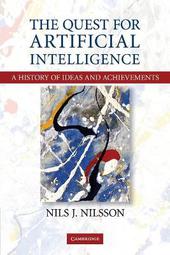
|
The Quest for Artificial Intelligence
Paperback / softback
Main Details
| Title |
The Quest for Artificial Intelligence
|
| Authors and Contributors |
By (author) Nils J. Nilsson
|
| Physical Properties |
| Format:Paperback / softback | | Pages:580 | | Dimensions(mm): Height 234,Width 155 |
|
| Category/Genre | History of science
Artificial intelligence |
|---|
| ISBN/Barcode |
9780521122931
|
| Classifications | Dewey:006.3 |
|---|
| Audience | | General | | Professional & Vocational | | Tertiary Education (US: College) | |
|---|
| Illustrations |
2 Tables, unspecified; 10 Plates, unspecified; 116 Halftones, unspecified; 101 Line drawings, unspecified
|
|
Publishing Details |
| Publisher |
Cambridge University Press
|
| Imprint |
Cambridge University Press
|
| Publication Date |
30 October 2009 |
| Publication Country |
United Kingdom
|
Description
Artificial intelligence (AI) is a field within computer science that is attempting to build enhanced intelligence into computer systems. This book traces the history of the subject, from the early dreams of eighteenth-century (and earlier) pioneers to the more successful work of today's AI engineers. AI is becoming more and more a part of everyone's life. The technology is already embedded in face-recognizing cameras, speech-recognition software, Internet search engines, and health-care robots, among other applications. The book's many diagrams and easy-to-understand descriptions of AI programs will help the casual reader gain an understanding of how these and other AI systems actually work. Its thorough (but unobtrusive) end-of-chapter notes containing citations to important source materials will be of great use to AI scholars and researchers. This book promises to be the definitive history of a field that has captivated the imaginations of scientists, philosophers, and writers for centuries.
Author Biography
Nils J. Nilsson, Kumagai Professor of Engineering (Emeritus) in the Department of Computer Science at Stanford University, California, received his PhD degree in Electrical Engineering from Stanford in 1958. He spent twenty-three years at the Artificial Intelligence Center of SRI International working on statistical and neural-network approaches to pattern recognition, co-inventing the A* heuristic search algorithm and the STRIPS automatic planning system, directing work on the integrated mobile robot, SHAKEY, and collaborating in the development of the PROSPECTOR expert system. He has published five textbooks on artificial intelligence. Professor Nilsson returned to Stanford in 1985 as the Chairman of the Department of Computer Science, a position he held until August 1990. Besides teaching courses on artificial intelligence and on machine learning, he has conducted research on flexible robots that are able to react to dynamic worlds, plan courses of action, and learn from experience. Professor Nilsson served on the editorial boards of the journal Artificial Intelligence and of the Journal of Artificial Intelligence Research. He was an Area Editor for the Journal of the Association for Computing Machinery. He is a past-president and Fellow of the American Association for Artificial Intelligence and is also a Fellow of the American Association for the Advancement of Science. He was a co-founder of Morgan Kaufmann Publishers, Inc. Professor Nilsson is a foreign member of the Royal Swedish Academy of Engineering Sciences. He is a recipient of the IEEE Neural-Network Pioneer award, the IJCAI Research Excellence award, and the AAAI Distinguished Service award.
Reviews'... [a] balanced look at what AI has been able to do during its first 50 years of existence. His personal recollections and the rationale behind many decisions, as retold by an insider, make this book a unique contribution, interesting both for the informed and for the general reader. Both kinds of readers can learn a lot from Nilsson's book about the evolution of this now-mature research field. The book is written in a friendly conversational style, without any unnecessary mathematical formalisms, and is richly illustrated with many diagrams that depict representative AI systems and photographs of the many innovators that led to their development.' Fernando Berzal, Reviews.com
|